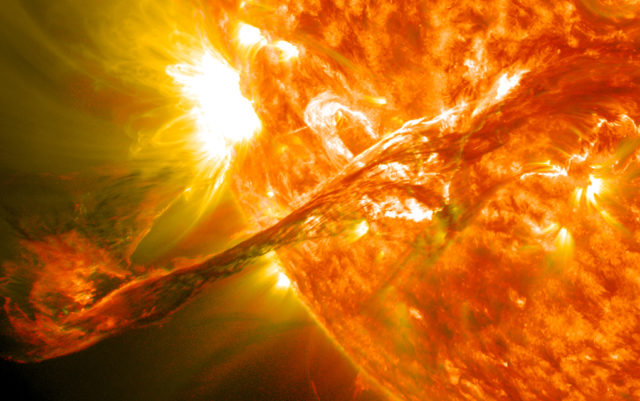
In his recent book Accessory to War, astronomer Neil deGrasse Tyson and coauthor Avis Lang document the historical relationship between science and the military, describing it as an uneasy alliance in which knowledge flows in both directions. For example, science has thrived in the age of the internet, which was created by the military as a communications medium capable of withstanding nuclear war. On the other hand, the military has drawn upon scientific expertise to explain mysterious events, and to avoid unnecessary escalation. A particularly dramatic case was published by a local researcher last month, detailing a 1972 solar storm that apparently detonated thousands of sea mines during the Vietnam War.
Solar storms occur when magnetic fields near the surface of the Sun become twisted and suddenly release a burst of energy. The harmful radiation from such events takes less than 10 minutes to reach the Earth, where much of it is absorbed by the atmosphere. The massive clouds of charged particles that get swept up by the bursts usually take a few days to reach our planet. They slam into the atmosphere near the magnetic poles and create shimmering curtains of light in the sky known as aurora. But these solar ejections can also damage orbiting satellites, and wreak havoc on power grids and communications systems on the ground.
The biggest solar storm in recorded history took place in September 1859, as British astronomer Richard Carrington was actually watching. While sketching a detailed image of a sunspot, features that are now known to be strongly magnetic, he witnessed a fantastic burst of energy in real time.
The eruption was so powerful that the associated cloud of material reached the Earth less than a day later. Aurora could be seen as far south as Panama, and the red skies were so bright in Denver that the fire department spent hours searching the city for a burning building that didn’t exist. The event was named after Carrington, and serves as a benchmark for the intensity of other solar storms throughout history.
“There are things that the Sun can do that put us in very precarious positions,” says Delores Knipp, a research professor in the Aerospace Engineering Sciences department at the University of Colorado and a senior research associate at the National Center for Atmospheric Research (NCAR).
As the daughter of a farmer, Knipp grew up with an interest in weather forecasting. To pay her way through college she joined the Air Force ROTC, the start of more than 20 years in military service. In the late 1980s, the Air Force sent her to do graduate studies in the emerging field of space weather. One of her Ph.D. supervisors was a scientist at NCAR, a connection that would ultimately bring her back to Boulder in 2008.
Two years ago, Knipp uncovered the story of how a solar storm led the United States and the Soviet Union to the brink of nuclear war in 1967. It was the height of the Cold War, and the U.S. had deployed several new radar stations across the northern hemisphere to act as an early warning system for ballistic missiles. Just weeks after the new defense system was in place, it suddenly stopped working.
“The radio disturbances from the Sun were so strong that they caused the radars to appear to be jammed,” Knipp explains.
At the time, military leaders assumed that the Soviets were intentionally jamming the radars in preparation for an attack. Fighter pilots were scrambled, and the world was within minutes of a nuclear confrontation.
Fortunately, the military had established its first space weather program a few years earlier, and scientists confirmed that the Sun was responsible for the radar outage before any nuclear-armed aircraft left the runway.
After reading about the 1967 events, one of Knipp’s colleagues contacted her about another military incident several years later. In the early 1970s, he had been working in what is now the Space Weather Prediction Center at NOAA when a group of Navy officers and a few people in dark suits visited his boss. He wasn’t inside the meeting, but he knew it was related to some military impact of a recent solar storm. Knipp wondered if it might be the strong storm that took place in August 1972, and she eventually found the military reports that described what happened.
Late in the Vietnam War, the U.S. placed thousands of sea mines around major ports in an attempt to choke off supply routes to North Vietnam and bring an end to the conflict. The mines had magnetic triggers that were designed to detect passing ships. When the solar storm hit the region, it created a sudden magnetic fluctuation that caused thousands of mines to explode within minutes. The solar storm was effectively a giant mine sweeper that set back the military operation by months.
“The August 1972 event was much more extreme than anyone seemed to recognize,” Knipp says. “Had the astronauts been on their way to the moon, they probably would have suffered severe radiation sickness.”
The 1972 storm is now thought to have been almost as powerful as the Carrington event of 1859, even though the aurora were less visible. It suggests that disruptive solar storms are more common than previously assumed. Both the military and the general public are more dependent on vulnerable technology than ever before, so scientists are now building the capacity to predict future events rather than just learning from history.
Travis Metcalfe, Ph.D., is a researcher and science communicator based in Boulder. The Lab Notes series is made possible in part by a research grant from the National Science Foundation.














